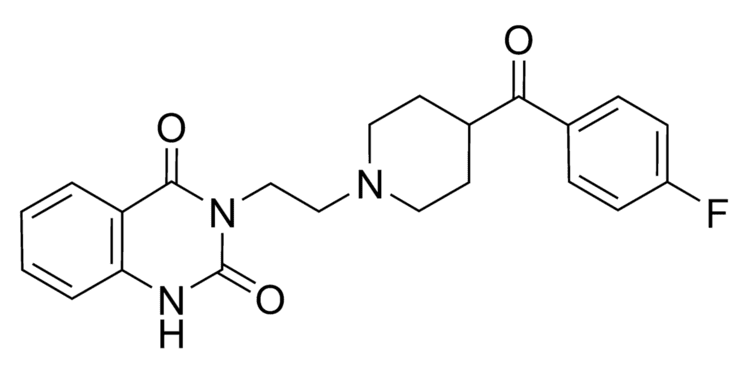Trade names Sufrexal PubChem CID 3822 | CAS Number 74050-98-9 | |
 | ||
AHFS/Drugs.com International Drug Names ATC code C02KD01 (WHO) QD03AX90 (WHO) Synonyms R41468; R-41468; R-41,468 | ||
Ketanserin (INN, USAN, BAN) (brand name Sufrexal; former developmental code name R41468) is a drug used clinically as an antihypertensive agent and in scientific research to study the serotonin system; specifically, the 5-HT2 receptor family. It was discovered at Janssen Pharmaceutica in 1980.
Contents
Medical use
Ketanserin is classified as an antihypertensive by the World Health Organization and the National Institute of Health.
It has been used to reverse pulmonary hypertension caused by protamine (which in turn was administered to reverse the effects of heparin overdose).
The reduction in hypertension is not associated with reflex tachycardia.
It has been used in cardiac surgery.
Research use
With tritium (3H) radioactively labeled ketanserin is used as a radioligand for serotonin 5-HT2 receptors, e.g. in receptor binding assays and autoradiography. This radio-labeling has enabled the study of serotonin 5-HT2A receptor distribution in the human brain.
An autoradiography study of the human cerebellum has found an increasing binding of 3H-ketanserin with age (from below 50 femtomol per milligram tissue at around 30 years of age to over 100 above 75 years). The same research team found no significant correlation with age in their homogenate binding study.
Ketanserin has also been used with carbon (11C) radioactively labeled NNC112 in order to image cortical D1 receptors without contamination by 5-HT2 receptors.
Pharmacology
Ketanserin is a high-affinity non-selective antagonist of 5-HT2 receptors in rodents, with Ki values of 2–3 nM for the 5-HT2A receptor and 28 nM for the 5-HT2C receptor). In primates including humans however, ketanserin is a more selective antagonist of the 5-HT2A over the 5-HT2C receptor, with Ki values of 2–3 nM for the 5-HT2Areceptor and 130 nM for the 5-HT2C receptor. In addition to the 5-HT2 receptors, ketanserin is also a high affinity antagonist for the H1 receptor (Ki = 2 nM), and has measurable albeit relatively low affinity for a number of other receptors:
It has also been found to block the vesicular monoamine transporter 2 (VMAT2).
